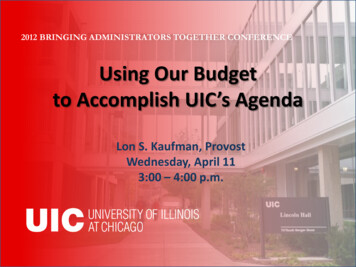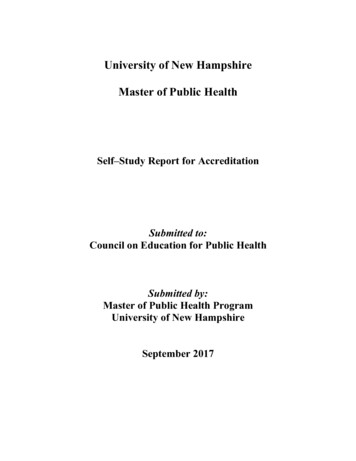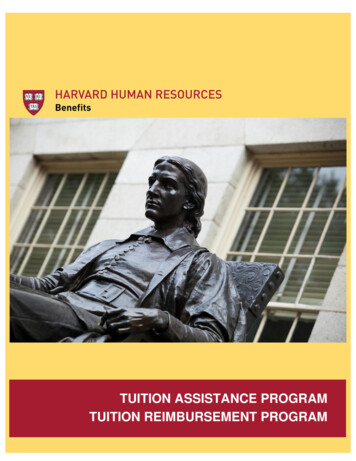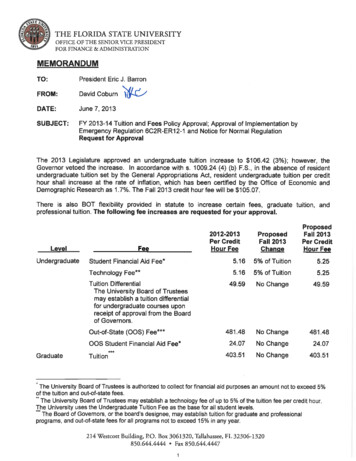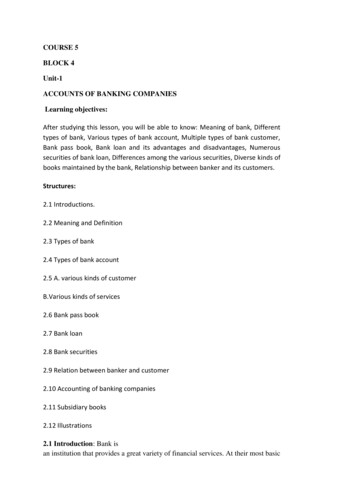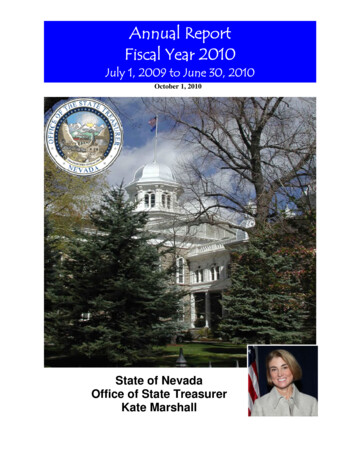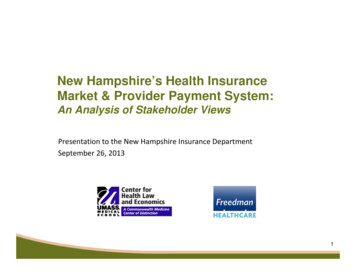
Transcription
New Hampshire College Tuition Savings Plan Advisory CommissionMinutes of the Meeting of May 16, 2016The May 16, 2016 meeting of the New Hampshire College Savings Plan Advisory Commission(“Advisory Commission”), held at the offices of the New Hampshire Higher EducationAssistance Foundation in Concord, was called to order at 10:00 a.m. by Dr. Edward MacKay,Advisory Commission Chair.Members present, constituting a quorum, were:Edward MacKay (Chair)Tori BerubeMichael CryansBill DwyerRoss GittellThomas HorganDavid MahoneyPublic Member, appointed by the Governor; RetiredChancellor, University System of New HampshireVice President, representing the NH HigherEducation Assistance Foundation Organizations(“NHHEAF”)Public Member, appointed by the GovernorState TreasurerChancellor, Community College System of NewHampshirePresident & CEO, representing the New HampshireCollege and University Council HampshireRepresenting the Higher Education Commission –Dept. of EducationMembers absent were:Lou D’AlessandroJeanie ForresterSylvia LarsenTodd LeachLynne OberLaurie SanbornState SenatorState SenatorRepresenting the Governor; Retired State SenatorChancellor, University System of New HampshireState RepresentativeState RepresentativeAlso present at the meeting were Kyla Doyle, Keith Bernhardt, Matt Golden, Peter Walsh,Andrew Dierdorf, and Sarah Pulsifer from Fidelity Investments (“Fidelity”), and MonicaMezzapelle from State Treasury.Review of Prior Meeting MinutesMinutes of the February 29, 2016 regular meeting were reviewed and presented for approval byDr. MacKay. After hearing no discussion, Dr. MacKay asked for a motion to approve theminutes. Approval was moved by Dr. Gittell and seconded by Mr. Cryans. The motion passedunanimously.Summary of Investment Committee Meeting
College Savings Plan Advisory CommissionMinutes of the Meeting – May 16, 2016Page 2 of 7After hearing presentations from the Fidelity team, led by Mr. Peter Walsh, InstitutionalPortfolio Manager for the Fidelity managed-529 plans, and Mr. Andrew Dierdorf, PortfolioManager of several Fidelity funds, Dr. MacKay provided a brief summary of the InvestmentCommittee meeting, which preceded the regular meeting. During the Investment Committeemeeting Mr. Walsh and Mr. Dierdorf presented an overview of the Capital Markets during thefirst quarter of 2016, highlighting that it was a volatile quarter.Mr. Dierdorf stated the U.S. economy is experiencing some signs of the late business cycle and aglobal monetary policy continued predominantly accommodative, especially in the U.S., Europe,and Japan, in order to support future economic growth. Even with growth challenges overseas,the U.S. economy continued to grow supported by a healthy labor market and growing wages.The best performers of this quarter were emerging markets debt and inflation protected debt(TIPs). The worst performers were non-U.S. equities and short-term debt.Dr. MacKay reminded Commission members that during the last quarter, Fidelity made somechanges to the asset allocation based on investment research, increasing allocations to sectorsexpected to benefit in the current environment and reducing exposure in others. Mr. Dierdorfstated asset allocations continue slightly overweight in equities, while underweight in fixedincome and short-term debt. Mr. Dierdorf and Mr. Walsh were pleased to report that ActiveAsset Allocation brought in 30-35 bps to the plans during the quarter.Fidelity will continue routine reviews of its position in accordance with its investment strategy,supported by active allocation, fund management, and a robust research team. Fidelity will alsomonitor market volatility, pace of monetary tightening, global trade in China, rapid strengtheningof the U.S. dollar, and geopolitical destabilization.Before concluding the presentation, Ms. Sarah Pulsifer from Fidelity presented the UNIQUE andFidelity Advisory 529 Competitive Performance Update for quarter one of 2016. For theUNIQUE plan, top competitors were selected based on managers’ use of active and passivestrategies and in order to more closely compare performance, the funds were aligned byportfolios most in line with Fidelity’s equity allocation. Plans compared were T. Rowe Price(AK), Schwab (KS), Franklin Templeton (NJ), USAA (NV), and Multi-Firm funds (NH) toFidelity Funds (NH). Similarly, for the advisor-sold plans, funds were aligned by the portfoliosmost in line with Fidelity’s equity allocation, which compared American Funds (VA), JohnHancock (AK), Blackrock (OH), and Alliance Bernstein (RI) to Fidelity (NH). Overall, the NHplans continue to perform positively and in line with competitors.Administrative Rules – Adoption of Rule Csp 300 & Csp 600, Conditional ApprovalResponse of Rule Csp 700, and Adoption of Csp 700Dr. MacKay reported that all the filings submitted by the State Treasury to the Office ofLegislative Services (“OLS”) were approved by the Joint Legislative Committee onAdministrative Rules (“JLCAR”) during its March 18th meeting. As a result, the AdvisoryCommission took the following actions during this meeting:
College Savings Plan Advisory CommissionMinutes of the Meeting – May 16, 2016Page 3 of 71. Adoption of Rule Csp 300 and Csp 600After JLCAR approval, the rule requires adoption by the Advisory Commission and itbecomes effective upon notification to the OLS. Dr. MacKay requested a motion to adoptRules Csp 300 and Csp 600. Mr. Cryans moved and Treasurer Dwyer seconded. The motionpassed unanimously.2. Conditional Approval Response of Rule Csp 700During the last meeting the Commission had an opportunity to review and approve the DraftConditional Approval Request for Rule Csp 700. The corresponding document was filedwith the OLS on March 1st and was subsequently approved by the JLCAR on March 18th.The next step is for the Advisory Commission to formally concur with such approval byfiling a Conditional Approval Response. Upon concurrence by the Advisory Commission,the filing was hand-delivered to the OLS for confirmation and the Advisory Commission wasready to adopt Rule Csp 700 during this meeting. Therefore, Dr, MacKay requested a motionto formally concur with the JLCAR approval. Mr. Mahoney moved and Dr. Gittellseconded. The motion passed unanimously.3. Adoption of Rule Csp 700After receiving confirmation that the OLS accepted the Conditional Approval Response ofRule Csp 700, the Advisory Commission proceeded to adopt Rule Csp 700. Dr. MacKayrequested a motion to adopt Rule Csp 700. Treasurer Dwyer moved and Dr. Gittellseconded. The motion passed unanimously.Dr. MacKay informed the Commission the State Treasury will file the proper documentationwith the OLS requesting that the rules be adopted immediately. Dr. MacKay was pleased toannounce that this concluded the rules update process and the 529 Plan and UNIQUE scholarshipprograms will now have updated rules for the proper operation of the programs as required byRSA 195-H:3 and RSA 6:40.Update of Endowment Trust Fund and Scholarship DisbursementsTreasurer Dwyer presented the Endowment Trust Fund results for quarter ended March 31, 2016and indicated the Endowment Trust Fund as of March 31st had a balance of over 3.3 million, anincrease of approximately 270,000 or 8.9% since the last quarter. Since the beginning of thefiscal year, the fund has received nearly 9.5 million in management fee income andapproximately 94,000 in interest and dividend earnings and net market gains. In addition, fromprogram inception, 128 million in account management revenue has been received and over 5.4 million in investment management income has been earned by the Endowment Trust Fund,while over 94 million has been disbursed for the UNIQUE Annual and Endowment Allocationprograms.
College Savings Plan Advisory CommissionMinutes of the Meeting – May 16, 2016Page 4 of 7In this fiscal year, an initial allocation of nearly 1 million was distributed in July of 2015 toparticipating higher education institutions of the UNIQUE Annual Allocation Program. Theallocation was based on individual scholarship amounts of 700 each (full-time studentequivalent). Under the UNIQUE Endowment Allocation Program, over 7.7 million has beendistributed to participating institutions through March 31, 2016. In addition, administrativeexpenses for the quarter totaled 380,650, representing the annual payment toPricewaterhouseCoopers (“PwC”) for the two Plan audits of 303,000, the quarterly Treasuryoverhead allocations of 26,600, the endowment fund management fees of 8,220, the yearlymembership dues paid to the College Savings Foundation and College Savings Plan Network of 6,600, combined, the annual support services paid to the Division of Higher Education of 36,000, and the service award presented to Ms. Tara Payne of 230.Fiscal Year 2016 College Savings Program Budget ReviewTreasurer Dwyer presented the proposed fiscal year 2017 program budget of the NH CollegeTuition Savings Plan Advisory Commission.The fiscal year 2017 budget includes management fee income of 13.8 million as derived fromthe projected assets in the UNIQUE College Investing Plan and the Fidelity Advisor 529 Plan.The budget projects over 9.6 million in revenue on the direct-sold side (typically 70% of thetotal projected revenue) and over 4.1 million in revenue on the advisor-sold side.Program disbursements include the UNIQUE Endowment allocations of 11 million (80% of 13.8 million in revenue), which are paid monthly to the specific endowments each participatinginstitution maintains and the UNIQUE Annual Award Scholarship amount of 2.3 million. TheAnnual Award Scholarship amount is derived from program revenues, less the budgetedEndowment Allocations and budgeted administrative expenses; therefore, the 2.3 million is notthe actual projection of Annul Awards, as the number of actual payouts could be more or lessdepending on the total amounts awarded by participating institutions during the 2017-18academic year. The Advisory Commission voted at its February 29 meeting to guaranteereimbursement requests submitted by participating institutions for Annual Awards granted inexcess of the initial allocation amount of 1 million. If the total Annual Awards granted aregreater than the budgeted amount, the Endowment Trust Fund balance will be used to cover whatis needed to fully fund the scholarship program.In addition to the scholarship programs, 92,000 is being budgeted for administrative expenses,which covers the audits of the two 529 plans contracted with PwC, association dues, thequarterly Treasury overhead allocations, the administrative support paid to the Division ofHigher Education, and miscellaneous expenses. After hearing no further discussion, Dr.MacKay asked the Advisory Commission for a motion to approve the fiscal year 2017 operatingbudget. Mr. Cryans moved to approve and Dr. Horgan seconded. The Advisory Commissionunanimously approved the fiscal year 2017 budget.Overview of the 529 Programs
College Savings Plan Advisory CommissionMinutes of the Meeting – May 16, 2016Page 5 of 7529 Industry Market UpdateMr. Golden presented the results of quarter one of 2016 529 Industry Update noting that NewHampshire continues as the fourth largest in the country with over 14.4 billion in market-valueassets under management and 6.1% of the industry’s market-share as of March 31, 2016.New Hampshire again trailed Virginia ( 52.5 billion in assets managed by American Funds),New York ( 21.8 billion, manage by J.P. Morgan), and the Nevada plans ( 16.5 billion,overseen by multiple managers, including Vanguard). Mr. Golden added the Alaska plan movedto ninth place trading positions with the Rhode Island plan which is now in 10th place.529 industry assets increased by 2.1% from quarter four 2015 to quarter one 2016 and increasedby 1.5% year over year. While New Hampshire’s assets, both plans combined, increased by1.7% from quarter four 2015 to quarter one 2016 and decreased by 0.4%, respectively during thesame time periods.Fidelity Advisor 529 Plan ReviewOn the 529 advisor-sold side, Mr. Golden reported 529 advisor-sold Plan assets increased by1.0% from quarter four 2015 to quarter one 2016 and decreased by 1.2% year over year endingMarch 31, 2016. While the Fidelity Advisor 529 Plan had over 4.2 billion in market-valueassets, distributed across 194,193 participant accounts, and a 3.9% of the market-share, as ofMarch 31, 2016. New Hampshire trailed Virginia ( 49.2 billion in assets), Maine ( 7.9 billion inassets), Rhode Island ( 6.7 billion in assets), and Ohio ( 4.6 billion in assets).The FA 529 Plan assets increased 0.6% from quarter four 2015 to quarter one 2016, but werelower by 3.5% year over year. New participant accounts decreased by 8.2% compared to quarterone 2015 and by 4.9% compared to quarter four in 2015. However, contributions increased by2.2% compared to quarter one of 2015 and by 1.1% compared to quarter four in 2015. Theaverage account size of the advisor-sold plan was 21,786, with New Hampshire residentsaveraging 21,030 in account balance.In response to inquiries of the Advisory Commission, Mr. Golden commented on the new U.S.Department of Labor (“DOL”) fiduciary rule, which impacts the advisor space. The new DOLrule requires investment advisers to operate under a “fiduciary” capacity and no longer under“suitability” for retirement assets. The fiduciary rule could increase liability for investmentadvisers and advisers may change how they do business. For example, advisers may change to afee-based compensation rather than commission-based. Fidelity is exploring options to respondto changes that this DOL rule may bring.Direct-sold (UNIQUE) 529 Plan ReviewOn the 529 Direct-sold side, Ms. Doyle reported the UNIQUE Plan surpassed again the 10billion mark, with over 10.1 billion in market-value assets and 8% of the market-share. TheUNIQUE Plan assets increased by 2.2% from quarter four 2015 to quarter one 2016 andincreased by 1% year over year. The Plan continued to trail New York with 18.0 billion inassets (14.2% market-share) and Nevada with 12.3 billion (9.7% market-share).
College Savings Plan Advisory CommissionMinutes of the Meeting – May 16, 2016Page 6 of 7Ms. Doyle pointed out that the market played a significant role during the period, the volatilityseen early in the quarter had an impact in account growth. As of March 31, 2016, the UNIQUEplan had 610,763 participant accounts, a reduction in the number of new accounts of 11.5%compared to last year and a growth rate reduction of 7.5% compared to quarter four of 2015. Dr.MacKay emphasized that despite the decline in account growth, the Plan gained 12,069 newaccounts in the quarter. Ms. Doyle added the Plan has already recovered in April, which will bereported in the next quarter. Contributions to the Plan increased for the quarter by 2% anddeclined by 3% compared to quarter one of 2015.The average account size in a UNIQUE account was 23,020, with New Hampshire residentsaveraging 19,157. In addition, the average monthly contributions to new and existing accountsnationwide were 3,874 and 147, respectively, with New Hampshire residents averaging 1,545in contributions to new accounts and 240 in contributions to existing accounts.Regulatory and Legislative ReportMs. Doyle also presented the Regulatory and Legislative update impacting the 529 industry. OnMarch 17, 2016 - Senators Burr (R-NC) and Casey (D-PA) along with Representatives Crenshaw(R-FL), Van Hollen (D-MD), McMorris Rodgers (R-WA), and Sessions (R-TX) introduced apackage of bills to enhance the ABLE Act – they include the following: The ABLE Financial Planning Act:To allow rollovers from 529 college savings plan to ABLE accounts. The ABLE to Work Act:To expand on the goals of the ABLE Act by encouraging self-sufficiency and work. Thelegislation allows individuals and their families to save more money in an ABLE accountif the beneficiary works and earns income. Specifically, an ABLE beneficiary who earnsincome from a job could save up to the Federal Poverty Level, which is currently at 11,770. The bill will also allow ABLE beneficiaries to qualify for the existing Saver'sCredit when they put savings in. The ABLE Age Adjustment Act:To raise the age limit for ABLE accounts from age 26 to age 46. Increasing the age limitfor ABLE accounts will allow more individuals to save in these accounts to help coverthe costs of short, medium and long-term care.Ms. Doyle indicated no programs have been implemented yet, but it is anticipated that Floridaand Nebraska may launch their programs in June 2016. Dr. MacKay stated that GovernorHassan signed SB 265 to allow an ABLE program in New Hampshire. Treasurer Dwyer addedthat due to the potential size of the program, New Hampshire could join a consortium with otherstates. Furthermore, the law contains three contingencies: 1) No general fund revenue can be
College Savings Plan Advisory CommissionMinutes of the Meeting – May 16, 2016Page 7 of 7used, 2) the final federal regulations need to be enacted, and 3) the State would need to havefound a third party provider for this program.Review of Other ItemsReport on the Children’s Savings Account legislationDr. MacKay provided an update on the recent activities of the commission on the Children’sSavings Account Program (“CSA”) pursuant to RSA 195-J.The purpose of the CSA program is to increase opportunities for college and career success forall students and to do so by encouraging positive postsecondary education savings behavior forlow and moderate income families and to provide, in cooperation with the public schools,financial literacy for all students and their parents. The CSA program is to begin with two pilotprograms consisting of creating savings accounts at a financial institution with a minimumdeposit of 50 for each eligible child attending public kindergarten in Coos County and in theCity of Manchester. The New Hampshire Charitable Foundation has pledged to match thefunding if initial seed money is provided by the State. The total estimated cost of the first year ofthe program is 65,000 for 1,300 students entering kindergarten in the two pilot locations. Onceimplemented, the intent is to eventually migrate the oversight and management of this programto the College Tuition Savings Plan Advisory Commission.SB 408 was introduced in this 2016 legislative session to appropriate 50,000 to the children’ssavings account fund pursuant to RSA 195-J:5. The bill was placed on the table and it isunlikely further action will be taken during this session. The CSA commission will now workon a proposal for the next legislative session to potentially introduce a fee that could be dedicatedto fund this program.Hearing no additional new business, Dr. MacKay adjourned the meeting at 11:40 a.m.NOTE: The next regular meeting is scheduled for Monday, August 22, 2016 beginning at 10:00a.m. at the New Hampshire Higher Education Assistance Foundation in Concord. The meetingwill be preceded by the Investment Committee meeting beginning at 9:00 a.m. All AdvisoryCommission members are invited to attend.
529 industry assets increased by 2.1% from quarter four 2015 to quarter one 2016 and increased by 1.5% year over year. While New Hampshire's assets, both plans combined, increased by 1.7% from quarter four 2015 to quarter one 2016 and decreased by 0.4%, respectively during the same time periods. Fidelity Advisor 529 Plan Review
